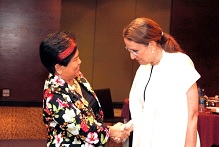
In a meeting with Sec. Corazon ‘Dinky’ Juliano-Soliman of the Department of Social Welfare and Development (DSWD), Ms. Rebeca Grynspan, United Nations (UN) Undersecretary General and Associate Administrator of the United Nations Development Programme (UNDP), expressed support for the government’s Conditional Cash Transfer Program (CCT), known locally as Pantawid Pamilyang Pilipino Program, and underscored its importance in breaking the cycle of poverty.
The visiting UN executive said that the CCT serves the younger generation and it should therefore “not be judged in the short term but after ten years when it can demonstrate success in breaking the intergenerational cycle of poverty.”
She added that the main purpose of a CCT programme is to avoid sacrificing the future of poor children that is why it is critical to support the program.
Sec. Soliman agreed and emphasized that the “Pantawid Pamilya” opens opportunities for children of poor families as they are given a “fighting chance” to change their destiny and breakaway from poverty.
Ms. Grynspan however pointed out that for the meantime, parents of these poor families should learn “how to fish” and be provided opportunities for employment.
School feeding as an incentive
Ms. Grynspan stressed that the return on investment from a CCT program will materialize only until after its beneficiaries finish schooling. Incentives are therefore important to ensure that completion materializes, she said.
She batted for school feeding which for her has been wrongly perceived.
“It is not just about feeding per se, it has a higher purpose of providing an incentive for poor children to stay in school,” she explained.
In Costa Rica, where she was Vice President from 1994 to 1998, Ms. Grynspan said the country’s school feeding program provided food twice – breakfast and lunch – resulting in higher attendance.
Sec. Soliman noted that the feeding program would be a good companion to the Pantawid Pamilya.
The Pantawid Pamilya provides conditional cash grants to poor households to improve their health, nutrition and education, particularly of children aged zero to 14. Beneficiaries receive the cash grants of a maximum of P1,400 per month (P500/month for health plus P900/month/per child with a maximum of three children per household for education) for five years as long as the conditions are complied with.
In 2007, Pantawid Pamilya was piloted in Metro Manila and in four other municipalities. A year after, the coverage for its first phase roll-out (Set 1) was increased to 28 provinces which included the 20 poorest provinces in the country based on the 2006 Official Poverty Statistics
As of October 2 of this year, the program is being implemented in all 1,627 cities and municipalities in 79 provinces in all 17 regions of the country. The registered households have reached 3,927,555 or 103.35% of the 3,809,769 target households for 2013.
The Philippine government has already allocated approximately P120 billion to the Pantawid Pamilya up to 2013.
Extend CCT to high school
Told by Sec. Soliman that the government plans to extend the Pantawid Pamilya to high school, Ms. Grynspan conceded to the reality that the labor market prefers higher schooling and it would give more advantage to poor children. She added that a portion of the CCT funds can be placed in individual savings of children as an incentive to complete high school. This scheme would make the child look forward to the financial means to pursue either a vocational course or other forms of higher learning
She also underlined the importance of disseminating the results of the evaluation of a CCT program. For her, this is the only way to convince the public that the program is worthwhile and that it is well-managed.
Millennium Development Goals
An advocate of human development, Ms. Grynspan has worked to focus global attention on addressing inequality, building social cohesion, empowering women and achieving the Millennium Development Goals (MDGs).
She urged for nutrition for early childhood development including newborns, an element she said that has weakened. Ms. Grynspan pointed that the zero to two-year period is critical because of its incredible effect on child development.
“Encourage mothers to breastfeed until at least six months and provide alternative sources of nutrition thereafter,” she insisted.
When informed that the Philippines was lagging behind in MDG to improve maternal health, she suggested that a package of interventions to reduce maternal mortality plus early childhood development would be very effective in addressing both the reduction of maternal and child mortalities.
Relocation and recovery
On the problem of relocation and recovery, Ms. Grynspan recognized that informal settlers experience a cycle of suffering from nature but that relocating them is added difficult challenge. She said that a structure like a park can be placed along the river and settlers can be moved farther.
Sec. Soliman responded that a three-meter easement and micro-buildings are can be options for that, an effort already being piloted among informal settler families in the National Capital Region.
According to Ms. Grynspan, providing housing after a disaster would be more effective if it is community-driven and if people support each other during their construction to effect solidarity.
Ms. Grynspan made her comments from her wide experience in social development especially in Latin America where the CCT program has been successfully implemented. She also served as Housing Minister, Coordinating Minister of Economy, Coordinating Minister of Social Affairs and Vice Minister of Finance. Later on, she became the Director of the Economic Commission for Latin America and the Caribbean or ECLAC, where she also served as Co-Chair of the International Food Policy Research Institute’s Executive Board. From 2006 to 2010, she was Assistant Secretary General and Regional Director for Latin America and the Caribbean at UNDP. In February 2010, she was appointed by UN Secretary General Ban Ki-moon as UN Undersecretary General and UNDP Associate Administrator. ###


